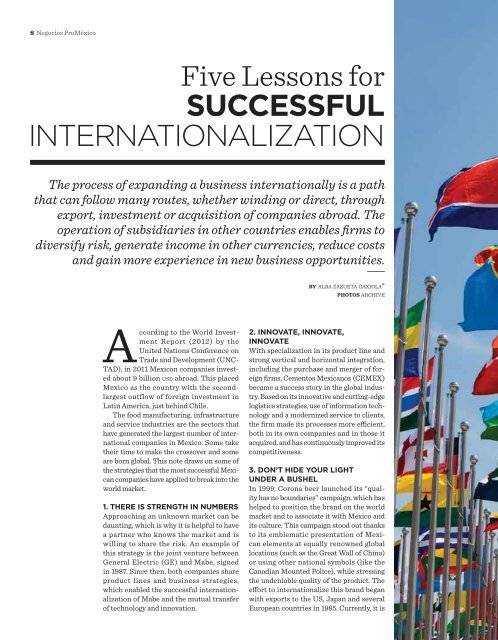Mexico’s Mining Industry
Mexico is a competitive destination for mining investment. An industry with a century-old tradition, mining remains one of the leading sources of income, employment and development in the country. But beyond the mineral wealth required to develop this activity, conditions in Mexico have made it one of the main destinations in the world for mining investment, surpassing countries that are richer in mineral resources.
Mexico is a competitive destination for mining investment. An industry with a century-old tradition, mining remains one of the leading sources of income, employment and development in the country. But beyond the mineral wealth required to develop this activity, conditions in Mexico have made it one of the main destinations in the world for mining investment, surpassing countries that are richer
in mineral resources.
Create successful ePaper yourself
Turn your PDF publications into a flip-book with our unique Google optimized e-Paper software.
8 Negocios ProMéxico Negocios ProMéxico 9<br />
Five Lessons for<br />
successful<br />
InternatIonalIzatIon<br />
The process of expanding a business internationally is a path<br />
that can follow many routes, whether winding or direct, through<br />
export, investment or acquisition of companies abroad. The<br />
operation of subsidiaries in other countries enables firms to<br />
diversify risk, generate income in other currencies, reduce costs<br />
and gain more experience in new business opportunities.<br />
____<br />
According to the World Investment<br />
Report (2012) by the<br />
United Nations Conference on<br />
Trade and Development (UNC-<br />
TAD), in 2011 Mexican companies invested<br />
about 9 billion usd abroad. This placed<br />
Mexico as the country with the secondlargest<br />
outflow of foreign investment in<br />
Latin America, just behind Chile.<br />
The food manufacturing, infrastructure<br />
and service industries are the sectors that<br />
have generated the largest number of international<br />
companies in Mexico. Some take<br />
their time to make the crossover and some<br />
are born global. This note draws on some of<br />
the strategies that the most successful Mexican<br />
companies have applied to break into the<br />
world market.<br />
1. There is sTrengTh in numbers<br />
Approaching an unknown market can be<br />
daunting, which is why it is helpful to have<br />
a partner who knows the market and is<br />
willing to share the risk. An example of<br />
this strategy is the joint venture between<br />
General Electric (GE) and Mabe, signed<br />
in 1987. Since then, both companies share<br />
product lines and business strategies,<br />
which enabled the successful internationalization<br />
of Mabe and the mutual transfer<br />
of technology and innovation.<br />
by alba zazueta gaxiola*<br />
photos archive<br />
2. innovaTe, innovaTe,<br />
innovaTe<br />
With specialization in its product line and<br />
strong vertical and horizontal integration,<br />
including the purchase and merger of foreign<br />
firms, Cementos Mexicanos (CEMEX)<br />
became a success story in the global industry.<br />
Based on its innovative and cutting-edge<br />
logistics strategies, use of information technology<br />
and a modernized service to clients,<br />
the firm made its processes more efficient,<br />
both in its own companies and in those it<br />
acquired, and has continuously improved its<br />
competitiveness.<br />
3. Don’T hiDe your lighT<br />
unDer a bushel<br />
In 1999, Corona beer launched its “quality<br />
has no boundaries” campaign, which has<br />
helped to position the brand on the world<br />
market and to associate it with Mexico and<br />
its culture. This campaign stood out thanks<br />
to its emblematic presentation of Mexican<br />
elements at equally renowned global<br />
locations (such as the Great Wall of China)<br />
or using other national symbols (like the<br />
Canadian Mounted Police), while stressing<br />
the undeniable quality of the product. The<br />
effort to internationalize this brand began<br />
with exports to the US, Japan and several<br />
European countries in 1985. Currently, it is<br />
distributed in over 170 countries and has<br />
established itself as the fourth most valuable<br />
beer brand in the world.<br />
4. all publiciTy<br />
is gooD publiciTy<br />
Who would have guessed that bad publicity<br />
could bring benefits to a company?<br />
Such was the case of the automaker Mastretta<br />
and its MXT sports car. In 2011,<br />
a British TV show called the first car to<br />
be 100% designed and manufactured in<br />
Mexico a product with a low level of competitiveness<br />
in the automotive industry.<br />
Rather than causing rejection, these assertions<br />
aroused the curiosity of consumers<br />
and led to the vehicle winning<br />
recognition on the specialist automobile<br />
market worldwide. The MXT is an elite<br />
sports car that is distributed only upon<br />
request and has been sold in the US, UK,<br />
South Korea and France, among other<br />
countries.<br />
5. Know your TargeT<br />
Identifying potential customers and affinities<br />
with the productive capacity of<br />
companies is crucial to advance the internationalization<br />
process and effectively<br />
measure business opportunities. Some<br />
companies have had to adapt their products<br />
to enter new markets. In the late<br />
1990s, the tortilla dough company Gruma<br />
made a full entry into the European market,<br />
positioning new bread products in a<br />
multicultural market. For that purpose,<br />
the group acquired a number of plants<br />
in Europe and Asia, indicating a growing<br />
international presence.<br />
Other Mexican companies such as<br />
Kidzania, Cinépolis, Nemak, Bimbo,<br />
América Móvil, TRALCOM, Ingenieros<br />
Civiles Asociados (ICA) and Sushi-Itto<br />
are also clear examples of the corporate<br />
consolidation that has been implemented<br />
across the globe in recent years. These<br />
companies have shown that the capacity<br />
to adapt and innovate is key to surviving<br />
the process of natural selection in an<br />
increasingly globalized economy. Moreover,<br />
it sets the challenge of continuing<br />
the successful internationalization of<br />
Mexican companies and brands in order<br />
to achieve the consolidation of Mexico as<br />
a hub for development and growth. n<br />
*Economist from the Tecnológico de Monterrey<br />
(ITESM). Holds a Masters in Economics from<br />
the University of Essex, UK.

















